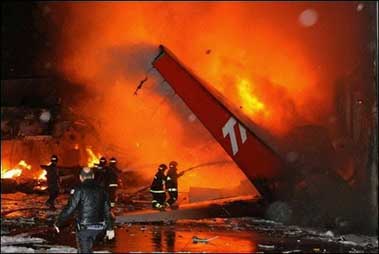TAM Linhas Aéreas Airbus A320-233 plane crash
São Paulo, Brazil

Updated on
 TAM Flight 3054 was a regular flight from Porto Alegre, Brazil, to São Paulo-Congonhas, Brazil. The plane was carrying 181 passengers and 6 crewmembers when it crashed on landing, killing all people onboard and 11 people on ground.
TAM Flight 3054 was a regular flight from Porto Alegre, Brazil, to São Paulo-Congonhas, Brazil. The plane was carrying 181 passengers and 6 crewmembers when it crashed on landing, killing all people onboard and 11 people on ground.
The Airbus A320, operated by TAM SA, the country's biggest airline, skid off the end of the rain-soaked runway on landing, cleared the airport fence at the end of the runway and the busy highway but slammed into a gas station and a TAM building, causing an inferno.
The video of the landing shows the plane speeding up after touching down very close to the designated limit for landings. The airline also said one of the Airbus 320's two thrust reversers was deactivated. Flying with only one thrust reverser is allowed and safe, but reduces braking power.
Approximately five minutes before the aircraft landed the captain highlights the fact that the right-hand thrust-reverser has been deactivated, stating:
Remember we only have one reverse.
The co-pilot acknowledges this, responding:Yes, only the left.
The approach goes normally, but two seconds from touchdown the recorder picks up the sound of thrust levers being moved and increased engine noise. This suggests that one of the plane's throttles was in the wrong position as it touched down, causing it to speed up instead of slow down. The crew may have failed to put the lever in the idle position, as requested for landing. But it is also possible the pilots had shifted the throttle lever correctly but that the plane's computer had failed to respond. In any case, having the throttle in the wrong position would have only complicated an already challenging landing for the pilots.As the aircraft lands, the co-pilot refers again to reversing only the left engine, but straight away afterwards states:
Spoilers nothing.
Spoilers would normally be deployed on landing to reduce lift from the wings and ensure that the aircraft makes firm contact with the runway surface.Less than five seconds later the co-pilot calls:
Decelerate, decelerate
But the captain responds:It can’t, it can’t.
Last words recorded from the crew are:go go go , turn turn turn turn
An A320 gets three devices to brake:- The wheel brakes,
- The spoilers or air-brake: small panels located on the wings that help braking by increasing the drag of the wings and giving the aircraft's wheels better traction, and
- The thrust reversers: engine device ejecting engine airflow forward, thus braking the plane.
Prior to touchdown at Sao Paulo, both thrust levers were in CL (or climb) position, with engine power being governed by the flight computer's autothrottle system.
At the moment of touchdown, the spoiler lever was in the ARMED position. According to the system logic of the A320's flight controls, in order for the spoilers to automatically deploy upon touchdown not only must the spoiler lever be in the ARMED position, but both thrust levers must be at or close to the idle position.
The pilot put the left thrust lever to the rear-most position, activating the thrust reverser on the left engine, while he let the right thrust lever (controlling the engine with the disabled thrust reverser) in the CL position. The pilots had only retarded the left engine to idle because they thought that without thrust reverser, the right engine did not need to be retarded as well. Airbus autothrust logic dictates that when one or more of the thrust levers is pulled to the idle position, the autothrust is automatically disengaged. Thus, when the pilot pulled the left engine thrust lever to idle it disconnected the autothrust system. Since the right engine thrust lever was still in the climb detent, the right engine accelerated to climb power while the left engine deployed its thrust reverser. The resulting asymmetric thrust condition resulted in a loss of control and a crash ensued. Moreover, the A320's spoilers did not deploy during the landing run, as the right thrust lever was above the idle setting required for automatic spoiler deployment.
Moreover, the runway itself could also have contributed to the accident: it was flooded at the time of the accident. The 6,362-foot runway at Sao Paulo's Congonhas airport has been repeatedly criticized as dangerously short. Two planes slipped off it in rainy weather just a day earlier. Pilots call it the "aircraft carrier" - it's so short and surrounded by heavily populated neighborhoods that they're told to take off again and fly around if they overshoot the first 1,000 feet of runway.




